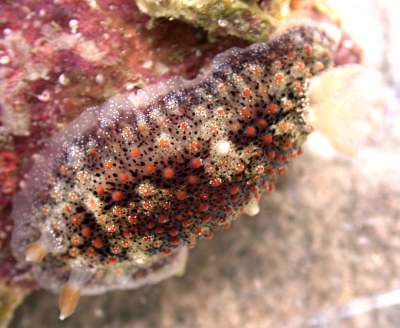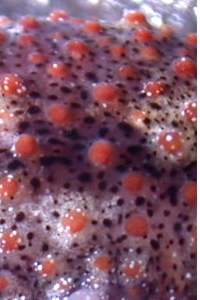Doriopsilla janaina from Mexico
April 17, 2002
From: Alicia Hermosillo

Dear Dr. Rudman,
I am sending you information and photos on a species of dorid, Doriopsilla janaina, that is not in your species list yet. I hope it will be of interest to someone.
Data: March 7th, 2002
Playa Mismaloya, Bahia de Banderas, Jalisco and Nayarit, Pacific Coast of Mexico
25 mm in length. On large rocks to a depth of 70 feet (personal observation).
This species is rather common in my area of study (I have seen 24 in my last 7 dives). When it is on its habitat, it is really cryptic, in order to find it I need to see the egg masses first (which on the other hand, are of a bright orange and very easy to spot) and then look around for D.janaina really hard. Hopefully soon I will be able to buy my housing and send you pictures of D. janaina underwater with its eggs, but for now this pictures will have to do.
I thank my friend Angel Valdes for information on this species, which I learned has a chemical compound (olepuapane) used as a natural insecticide (Okuda et al., 1983).
References:
• Marcus, Ev. y Marcus, Er. 1967. Tropical American Opisthobranchs. Studies in Tropical Oceanography, 6: 3-137, pl. 1.
• Gosliner, T.M. 1991. The opisthobranch gastropod Fauna of the Galapagos Islands. In: James, M.J. (ed.): Topics in Geobiology 8(13): 281-305. Galapagos Marine Invertebrates: taxonomy, biogeography, and evolution in Darwin's Islands. Plenum Press: New York. Xiv+474 pp.
• Okuda, R.K., Scheuer, P.J., Hochlowski, J.E., Walker, R.P. & Faulkner, D.J. 1983. Sesquiterpenoid constituents of eight porostome nudibranchs. Journal of Organic Chemistry, 48: 1866-1869.
Alicia Hermosillo
gueri25@hotmail.com


Dear Ali,
Thanks for these photos. I am sure they will interest many people. The few photos I have seen of this animal show it as quite a deep orange colour so your photos show an interesting variation in its colour. I look forward to some photos it on its sponge with eggs. As you have discovered, egga are an excellent clue to finding cryptic nudibranchs.
Best wishes,
Bill Rudman
